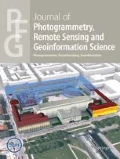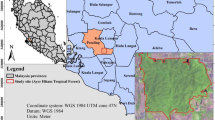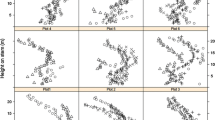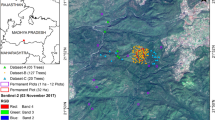Abstract
Accurate estimates of forest inventory parameters are essential to assess the potential hazards of wildfire and obtain above-ground biomass and carbon sequestration data that help develop strategies for the sustainable management of forests. This study aims to assess the accuracy of estimation of forest inventory parameters, such as diameter at breast height (DBH) and tree height, obtained using a Terrestrial Laser Scanner (TLS) in a Mediterranean coniferous stand in western Greece. DBH values measured in the field were compared with those derived from a TLS using the Computree algorithm for automatic DBH detection, and resulted in a coefficient of determination (\(R^{2})\) that ranged from 0.75 to 0.96 at the plot level. The average \(R^{2}\) and RMSE values of 0.80 and 1.07 m, respectively, were obtained when comparing the tree heights recorded by TLS and field data. Finally, the feasibility of TLS to estimate total dry biomass was investigated by comparing the TLS-derived total dry biomass values with those derived from field estimates using an allometric equation. The average estimate of biomass per hectare according to the TLS inventory data was 373.17 Mg/ha while that from field observations was 366.82 Mg/ha. The results confirm that TLS can provide non-destructive, high-resolution and precise determination of forest inventory parameters. The outcomes of this research will help researchers to better comprehend deviations in the accuracy of forest inventory variable retrieval resulting from the variation in the processing parameters supplied and additionally boost decision-making in forest management.
Zusammenfassung
Einsatz von terrestrischem Laserscanning zur Bestimmung von Forstinventurparametern in einem mediterranen Kiefernwald im westlichen Griechenland. Eine genaue Abschätzung von Parametern der Waldinventur ist wichtig, um potenzielle Waldbrandgefahr zu erkennen oder Daten zur oberirdischen Biomasse und Kohlenstoffbindung zu erhalten. Diese sind wiederum bei der strategischen Planung für nachhaltiges Waldmanagement von Nutzen. Ziel dieser Arbeit ist die Bewertung der Genauigkeit von aus terrestrischem Laserscanning (TLS) abgeleiteten Waldparametern Brusthöhendurchmesser (DBH) und Baumhöhe. Dazu wurde eine Studie in einem Koniferenschlag im Mittelmeerraum, Westgriechenland, durchgeführt. Zur automatisierten Ableitung des TLS-basierten DBH wurde der Computree-Algorithmus verwendet. Im statistischen Vergleich mit Feldmessungen des DBH wurden auf der Plot-Ebene Bestimmtheitsmaße zwischen 0,75 und 0,96 erreicht. Bei der Baumhöhenabschätzung mittels TLS wurden im Vergleich mit den Aufnahmen auf der Plot-Ebene Bestimmtheitsmaße von 0,8 und mittlere quadratische Abweichungen von 1,07 m ermittelt. Abschließend wurde untersucht, inwieweit sich Ableitungen der gesamten trockenen Biomasse eine allometrische Gleichung unterscheiden, wenn sie auf TLS-Ergebnisse oder Bodenmessungen angewendet werden. Es wurde mit 373,17 Mg/ha für TLS und 366,82 Mg/ha für Bodenmessungen nur eine geringe Abweichung zwischen den beiden Eingangsdaten zur Bestimmung der Biomasse festgestellt. Die Ergebnisse unterstreichen die Eignung von TLS als Methode zur nicht-destruktiven, hoch-aufgelösten und genauen Bestimmung von Parametern der Waldinventur. Die Ergebnisse können zukünftigen Forschungsarbeiten zu einem besseren Verständnis von Abweichungen in der Genauigkeit bei der Nutzung von Eingabeparametern unterschiedlicher Herkunft dienen und Entscheidungsfindungen im Waldmanagement unterstützen.









Similar content being viewed by others
References
Aldred A, Bonner G (1985) Application of airborne lasers to forest surveys. Agriculture Canada, Ministry of State for Forestry, Petawawa National Forestry Institute, Chalk Rover, Canada
Aschoff T, Spiecker H (2004) Algorithms for the automatic detection of trees in laser scanner data. Int Arch Photogramm Remote Sens Spat Inf Sci 36:71–75
Calders K, Newnham G, Burt A, Murphy S, Raumonen P, Herold M, Culvenor D, Avitabile V, Disney M, Armston J (2015) Nondestructive estimates of above-ground biomass using terrestrial laser scanning. Methods Ecol Evol 6:198–208
Calders K, Newnham G, Herold M, Murphy S, Culvenor D, Raumonen P, Burt A, Armston J, Avitabile V, Disney M (2013) Estimating above ground biomass from terrestrial laser scanning in Australian Eucalypt open forest. In: Proceedings SilviLaser 2013, Beijing, pp 90–97
Canadell JG, Raupach MR (2008) Managing forests for climate change mitigation. Science 320:1456–1457
Carlson TN, Ripley DA (1997) On the relation between NDVI, fractional vegetation cover, and leaf area index. Remote Sens Environ 62:241–252
Denman KL, Brasseur GP, Chidthaisong A, Ciais P, Cox PM, Dickinson RE, Hauglustaine DA, Heinze C, Holland EA, Jacob DJ (2007) Couplings between changes in the climate system and biogeochemistry. In: Solomon S, Qin D, Manning M, Chen Z, Marquis M, Averyt KB, Tignor M, Miller HL (eds) Climate change 2007: the physical science basis. Contribution of working group I to the fourth assessment report of the intergovernmental panel on climate change. Cambridge University Press, Cambridge, pp 663–745
Frankis M (1999) Plate 367. Pinus brutia. Curtis Bot Mag 16:173–184. doi:10.1111/1467-8748.00216
Hopkinson C, Chasmer L, Young-Pow C, Treitz P (2004) Assessing forest metrics with a ground-based scanning lidar. Can J For Res 34:573–583
Kalwar OPP (2015) Derivation of forest plot inventory parameters from terrestrial LiDAR data for carbon estimation. University of Twente, Faculty of Geo-Information and Earth Observation (ITC)
Kankare V, Holopainen M, Vastaranta M, Liang X, Yu X, Kaartinen H, Kukko A, Hyyppä J (2017) Outlook for the single-tree-level forest inventory in Nordic countries. In: Ivan I, Singleton A, Horák J, Inspektor T (eds) The rise of big spatial data. Springer, Cham, pp 183–195. doi:10.1007/978-3-319-45123-7_14
Kankare V, Holopainen M, Vastaranta M, Puttonen E, Yu X, Hyyppä J, Vaaja M, Hyyppä H, Alho P (2013) Individual tree biomass estimation using terrestrial laser scanning. ISPRS J Photogramm Remote Sens 75:64–75. doi:10.1016/j.isprsjprs.2012.10.003
Karna Y (2012) Mapping above ground carbon using worldview satellite image and lidar data in relationship with tree diversity of forests. Master’s thesis, Faculty of Geoinformation Science and Earth Observation, University of Twente, The Netherlands
Király G, Brolly G (2008) Modelling single trees from terrestrial laser scanning data in a forest reserve. Photogramm J Finl 21:37–50
Klaus W, Ehrendorfer F (1989) Mediterranean pines and their history. In: Ehrendorfer F (ed) Woody plants—evolution and distribution since the Tertiary. Proceedings of a symposium organized by Deutsche Akademie der Naturforscher Leopoldina in Halle/Saale, German Democratic Republic, 9–11 Oct 1986. Springer, Vienna, pp 133–163. doi:10.1007/978-3-7091-3972-1_8
Köhl M, Baldauf T, Plugge D, Krug J (2009) Reduced emissions from deforestation and forest degradation (REDD): a climate change mitigation strategy on a critical track. Carbon Balance Manag 4:1–10
Korontzi S, Roy DP, Justice CO, Ward DE (2004) Modeling and sensitivity analysis of fire emissions in Southern Africa during SAFARI 2000. Remote Sens Environ 92:255–275
Lefsky MA, Cohen WB, Parker GG, Harding DJ (2002) Lidar remote sensing for ecosystem studies Lidar, an emerging remote sensing technology that directly measures the three-dimensional distribution of plant canopies, can accurately estimate vegetation structural attributes and should be of particular interest to forest, landscape, and global ecologists. BioScience 52:19–30
Liang X, Kankare V, Hyyppä J, Wang Y, Kukko A, Haggrén H, Yu X, Kaartinen H, Jaakkola A, Guan F (2016) Terrestrial laser scanning in forest inventories. ISPRS J Photogramm Remote Sens 115:63–77
Lim K, Treitz P, Wulder M, St-Onge B, Flood M (2003) LiDAR remote sensing of forest structure. Progress Phys Geogr 27:88–106
López-Serrano FR, García-Morote A, Andrés-Abellán M, Tendero A, del Cerro A (2005) Site and weather effects in allometries: a simple approach to climate change effect on pines. For Ecol Manag 215:251–270. doi:10.1016/j.foreco.2005.05.014
Maas HG, Bienert A, Scheller S, Keane E (2008) Automatic forest inventory parameter determination from terrestrial laser scanner data. Int J Remote Sens 29:1579–1593. doi:10.1080/01431160701736406
Moskal LM, Zheng G (2011) Retrieving forest inventory variables with terrestrial laser scanning (TLS) in urban heterogeneous forest. Remote Sens 4:1–20
Ni-Meister W, Lee S, Strahler AH, Woodcock CE, Schaaf C, Yao T, Ranson KJ, Sun G, Blair JB (2010) Assessing general relationships between aboveground biomass and vegetation structure parameters for improved carbon estimate from lidar remote sensing. J Geophys Res Biogeosci 115:1–12
Othmani A, Piboule A, Krebs M, Stolz C, Voon LLY (2011) Towards automated and operational forest inventories with T-Lidar. In: 11th international conference on LiDAR applications for assessing forest ecosystems (SilviLaser 2011)
Pfeifer N, Briese C (2007) Laser scanning-principles and applications. Institute of Photogrametry and Remote Sensing, Vienna University of Technology, Vienna
Repola J (2009) Biomass equations for Scots pine and Norway spruce in Finland. Silva Fenn 43:625–647
Riveiro B, González-Jorge H, Conde B, Puente I (2016) Laser scanning technology: fundamentals, principles and applications in infrastructure. Non-Destr Tech Eval Struct Infrastruct 11:7
Song C, Dickinson MB, Su L, Zhang S, Yaussey D (2010) Estimating average tree crown size using spatial information from Ikonos and QuickBird images: across-sensor and across-site comparisons. Remote Sens Environ 114:1099–1107
Tansey K, Selmes N, Anstee A, Tate N, Denniss A (2009) Estimating tree and stand variables in a Corsican Pine woodland from terrestrial laser scanner data. Int J Remote Sens 30:5195–5209
Turner DP, Cohen WB, Kennedy RE, Fassnacht KS, Briggs JM (1999) Relationships between leaf area index and Landsat TM spectral vegetation indices across three temperate zone sites. Remote Sens Environ 70:52–68
Van Leeuwen M, Nieuwenhuis M (2010) Retrieval of forest structural parameters using LiDAR remote sensing. Eur J For Res 129:749–770. doi:10.1007/s10342-010-0381-4
Waring RH, Way J, Hunt ER, Morrissey L, Ranson KJ, Weishampel JF, Oren R, Franklin SE (1995) Imaging radar for ecosystem studies. BioScience 45:715–723
Watt PJ, Donoghue DNM (2005) Measuring forest structure with terrestrial laser scanning. Int J Remote Sens 26:1437–1446. doi:10.1080/01431160512331337961
Workie T (2011) Assessment of aboveground carbon stock in coniferous and broadleaf forests, using high spatial resolution satellite images. University of Twente Faculty of Geo-Information and Earth Observation (ITC), Enschede. http://www.itc.nl/library/papers_2011/msc/gem/workie.pdf
Xystrakis F, Psarras T, Koutsias N (2017) A process-based land use/land cover change assessment on a mountainous area of Greece during 1945–2009: signs of socio-economic drivers. Sci Total Environ 587–588:360–370. doi:10.1016/j.scitotenv.2017.02.161
Zhao K, Popescu S, Nelson R (2009) Lidar remote sensing of forest biomass: a scale-invariant estimation approach using airborne lasers. Remote Sens Environ 113:182–196
Acknowledgements
This research was made possible by financial support from the Erasmus Mundus Intact Mobility Program 2015. We would also like to thank the Department of Forestry and Natural Environment Management in Mesolonghi, Greece, for assistance in the field data acquisition.
Author information
Authors and Affiliations
Corresponding author
Rights and permissions
About this article
Cite this article
Ghimire, S., Xystrakis, F. & Koutsias, N. Using Terrestrial Laser Scanning to Measure Forest Inventory Parameters in a Mediterranean Coniferous Stand of Western Greece. PFG 85, 213–225 (2017). https://doi.org/10.1007/s41064-017-0024-1
Received:
Accepted:
Published:
Issue Date:
DOI: https://doi.org/10.1007/s41064-017-0024-1




